#robert catesby
Explore tagged Tumblr posts
Text
Yearly reminder that in 1605, Catholics legally couldn’t purchase gunpowder.
Furthermore, gunpowder could only be bought from the Tower of London, and every time gunpowder was bought from there it would be kept in a record. Now the records for all the surrounding years can be traced, yet the records for 1605 are mysteriously absent.
I’m not saying the Gunpowder Plot was a Protestant conspiracy, but I’m not saying the Gunpowder Plot wasn’t a Protestant conspiracy.
#november 5th#gunpowder plot#guy fawkes#robert catesby#remember remember the 5th of november#this is a genuine thing I had to write about in history the other week
15 notes
·
View notes
Text
Guy Fawkes and the Gunpowder Plot

By Ben Johnson
Published 30 October 2020
Remember, Remember, the 5th of November, Gunpowder, Treason and Plot!
Fireworks can be seen all over France every July 14 as the nation celebrates Bastille Day.
Across the USA some ten days earlier on the 4th of July, Americans celebrate their Independence Day.
In Britain, the words of a children’s nursery rhyme “Remember, Remember the 5th of November, Gunpowder, Treason and Plot” are chanted as fireworks fly and bonfires gradually consume a human effigy known as the ‘Guy.’
So who was this Guy? And why is he remembered so fondly 400 years after his death?
It could be said that the story started when the Catholic Pope of the day failed to recognise England’s King Henry VIII‘s novel ideas on separation and divorce.
Henry, annoyed at this, severed ties with Rome and appointed himself head of the Protestant Church of England.
Protestant rule in England was maintained and strengthened through the long and glorious reign of his daughter Queen Elizabeth I.
When Elizabeth died without children in 1603, her cousin James VI of Scotland became King James I of England.
James had not been long on the throne before he started to upset the Catholics within his kingdom.
They appear to have been unimpressed with his failure to implement religious tolerance measures, getting a little more annoyed when he ordered all Catholic priests to leave the country.
A group of Roman Catholic nobles and gentlemen led by Robert Catesby conspired to essentially end Protestant rule with perhaps the biggest ‘bang’ in history.
Their plan was to blow up the King, Queen, church leaders, assorted nobles, and both Houses of Parliament with 36 barrels of gunpowder strategically placed in the cellars beneath the Palace of Westminster.
The plot was apparently revealed when the Catholic Lord Monteagle was sent a message warning him to stay away from Parliament as he would be in danger, the letter being presented to Robert Cecil, James I’s Chief Minister.


Some historians believe that Cecil had known about the plot for some time and had allowed the plot to ‘thicken’ to both ensure that all the conspirators were caught and to promote Catholic hatred throughout the country.
And the Guy? Guy Fawkes was born in Yorkshire on 13 April 1570.
A convert to the Catholic faith, Fawkes had been a soldier who had spent several years fighting in Italy.
It was during this period that he adopted the name Guido (Italian for Guy), perhaps to impress the ladies.
What we do know is that Guido was arrested in the early hours of the morning of November 5th 1605, in a cellar under the House of Lords, next to the 36 kegs of gunpowder, with a box of matches in his pocket and a very guilty expression on his face.
Under torture, Guy Fawkes identified the names of his co-conspirators. Many of these were the relations of a Catholic gentleman, Thomas Percy.
Catesby and three others were killed by soldiers while attempting to escape.
The remaining eight were imprisoned in the Tower of London before being tried and executed for High Treason.
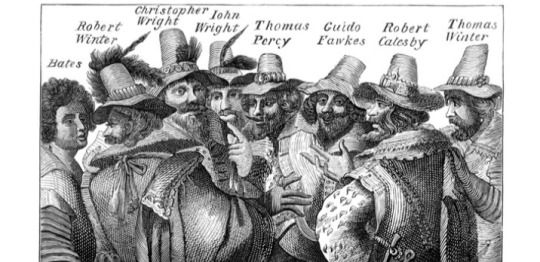
They experienced that quaint English method of execution, first experienced almost 300 years earlier by William ‘Braveheart’ Wallace.
They too were hanged, drawn, and quartered.
*Hanged, drawn and quartered:
Victims were dragged on a wooden hurdle behind a horse to the place of execution where they were first of all hanged, then their genitals were removed.
They were disembowelled and beheaded.
Their bodies were finally quartered, the severed pieces often displayed in public.

—
Guy Fawkes (13 April 1570 – 31 January 1606), also known as Guido Fawkes while fighting for the Spanish, was a member of a group of provincial English Catholics involved in the failed Gunpowder Plot of 1605.
The Gunpowder Plot of 1605, in earlier centuries often called the Gunpowder Treason Plot or the Jesuit Treason, was an unsuccessful attempted regicide against King James I by a group of English Catholics led by Robert Catesby, who considered their actions attempted tyrannicide and who sought regime change in England after decades of religious persecution.
The plan was to blow up the House of Lords during the State Opening of Parliament on 5 November 1605, as the prelude to a popular revolt in the Midlands during which King James's nine-year-old daughter, Princess Elizabeth, was to be installed as the new head of state.
#Guy Fawkes#Guido Fawkes#Gunpowder Plot of 1605#Gunpowder Treason Plot#Jesuit Treason#King James I#Robert Catesby#5 November 1605#House of Lords#State Opening of Parliament#King Henry VIII#Queen Elizabeth I#King James I of England#Palace of Westminster#Lord Monteagle#Robert Cecil#Thomas Percy#Tower of London#High Treason
50 notes
·
View notes
Text
Ryu Number: Robert Catesby
Everyone remembers Guy Fawkes and the Gunpowder Plot of 1605—the plan to blow up the Protestant King James I and Catholicize his daughter—but the leader of the group was actually a guy (geddit?) named Robert Catesby. Unfortunately for Catesby, an anonymous letter revealed the whole deal early, and Guy Fawkes was discovered under the House of Lords with 36 barrels of gunpowder, which is an amount of explosives government employees generally prefer not to have beneath their feet (opinions may vary). Catesby ended up shot by the fuzz, and they put his head on a stick. He has a Ryu number of 3.


McPixel has a very clear policy when it comes to copyright infringement.







That policy is "enh don't worry about it."
One of the booms you have to cancel in the game is the one Guy Fawkes is putting together. There's even the location shown to make it absolutely clear:


As for the alternate route, you might already know that Lego Dimension lets you play as an absolute crazy range of characters including Sonic the Hedgehog and the Doctor (One to Twelve, plus a bonus War Doctor)...


... but have you ever played Doctor Who: The Adventure Games?
If not... well, tough luck. It was yanked from Steam after the license ran out. Suffice to say (and it'll have to suffice to say, unless you're up for Alternate Methods Of Procurement), you play as the Eleventh Doctor and Co., getting into a short number of Doctor-Who-type adventures that largely consist of interacting with items and avoiding enemy sight cones. One season of four episodes was released, as well as The Gunpowder Plot (the only pseudohistorical episode of the bunch), which was intended to be episode one of season two. Unfortunately, the project was cancelled in favor of...
*squint*
... Doctor Who: The Eternity Clock, apparently. Which IGN gave a 5.5/10, and that was one of the higher review scores. Oof.
#ryu number#robert catesby#super smash bros. ultimate#sephiroth#mcpixel#guy fawkes#doctor who: the adventure games#sonic the hedgehog#lego dimensions#the doctor
41 notes
·
View notes
Photo







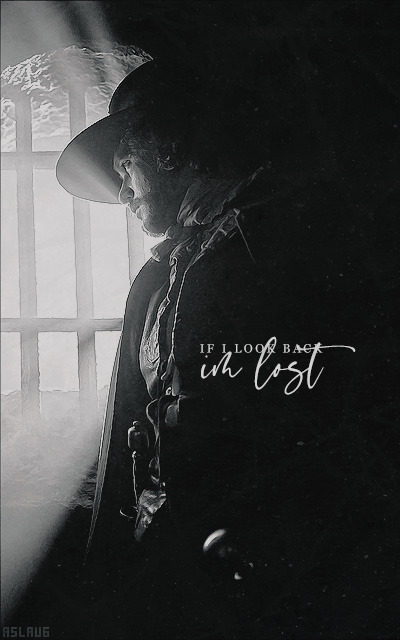

Kit Harington in Gunpowder (2017) as Robert Catesby
#kit harington avatars#gotcastedit#period fc#kharingtonedit#kitharingtonedit#gunpowderedit#robert catesby#kit harington#gunpowder#rp avatars#avatars 400*640#rpg resource#*avatars#*mine#n:50
84 notes
·
View notes
Note
Bobby Catesby/Julia Chaney
Send me a ship for the ship bingo chart: Bobby Catesby / Julia Chaney ( We Happy Few )
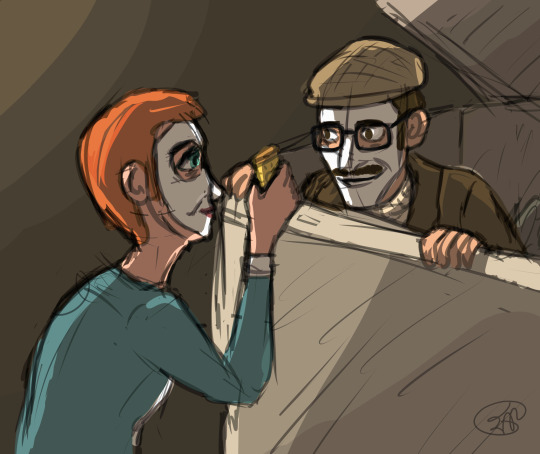

Ooo okay this one is really interesting and I have Thoughts™
Bobby Catesby, also known as the Shady Dealer, is the funky little guy who sells you black market good from a dumpster in the Village. Julia Chaney is the Wellette who tried to make her own homebrew drugs, screwed up the chemistry, and ended up murdering her entire household in a drug-induced violent outburst.
Julia buys the bulk of her chemistry ingredients from Stewart Adams’ shop, but there are bound to be things even he can’t get his hands on. I could see her going to Bobby for anything she couldn’t get the chemist’s.
One of the more interesting points about Julia is that, from her notes, she can surmise she’s trying to cook up a homebrew Sunshine due to the price of buying it direct from Sally. While Bobby sells some of the stuff himself, it’s likely around the same price as Sally’s (if not marked up).
There’s an implication there that Julia Chaney was either off her Joy or trying to be. While it’s unclear whether it’s a conscious choice, or if she started having a poor reaction to Joy and was trying not to be sent off to the Garden District, I find the later more interesting. But regardless, the fact remains that for whatever reason Sunshine has become a necessity in her life, and her pockets aren’t very deep.
I could see her going to ol’ Catesby’s dumpster shop now and then for ingredients and for any odds and ends she can’t acquire elsewhere. They strike up little conversations and a friendly sort of fondness grows between them. They’re both Wellies with a touch more self-awareness about the state of things than their neighbors, but neither are willing to give up the minor comforts of the Village to give up the Joy act and go full Downer.
While they don’t ever speak about it bluntly (they are still Wellies), Bobby becomes someone Julia can talk to about her minor grievances with the state of the world. There’s never enough to eat. Toxic fumes blocked the way to her friend’s house and she missed her Rummy game. Her husband has been more and more insufferable the longer she’s been on the yellow pill. Has he always been like this? It’s better than being alone and, without her allowance from him, she won’t be able to scrape together enough for food, much less Sunshine. And then she’ll be off to the Garden District or taken away by some doctor.
Every time she visits, Bobby always manages to get a sale out of it, even if she’s just stopping by for a chat. He is running a business after all. But he does enjoy their little chats and gives her a special deal if she’s having a particularly bad day.
Julia’s a bit more fond of him than she should be, considering her husband. While nothing would ever come of it, their feelings towards each other aren’t romantic, but aren’t strictly platonic either. He’d cut her even more of a deal on sales if he could, but then he’d be making no profit at all and he does have a business to run.
The last time Bobby Catesby sees Julia Chaney, she in good spirits. She doesn’t want to spill the beans, but she does let on that she got her hands on something that is sure to turn things around in her life (Sally's chemistry notes). No more penny pinching for Sunshine in her future. He tells her that’s brilliant news and cracks a joke about how he hopes this doesn’t mean he’ll be losing her as a customer. She says if it all works out, she’ll have the means to be his biggest customer yet.
They wish each other a lovely day and a promise to chat again next week.
Next week roles around and Julia hasn’t stopped by the dumpster shop. Another week the same.
Word on the street is that the Chaneys have gone on holiday and the Mrs. is to blame.
Bobby Catesby’s business carries on as usual, but he misses their little chats, and wonders if that new venture of hers is what finally sent her full Downer, poor thing.
#we happy few#the shady dealer#julia chaney#whf#robert catesby#f; we happy few#another pairing i never would have thought of and now I'm all up in my feelings about them
5 notes
·
View notes
Text
The Siege of Holbeach House - 08 Nov 1605
On This Day (08 Nov) in 1605, 200 men led by Robert Walsh, Sheriff of Worcester, converged on Holbeach House, near Kingswinford, on the Staffordshire border, where many of the Gunpowder Plot conspirators had gathered, including plot mastermind Robert Catesby and 'belligerent' Thomas Percy.

The men were tired, wet and demoralised. Their plot to blow up Parliament had been foiled, an arrest warrant had immediately been issued for Percy, and the Catholic support they hoped to gather in the Midlands did not materialise. Some of the plotters, including Catesby, had been injured by gunpowder accidentally setting alight the previous day. Regardless, the men refused to surrender, being prepared to die for their cause.
Catesby and Percy were reportedly killed by the same bullet; he reportedly crawled into the house, grasping a picture of the Virgin Mary before dying. Percy's wounds do not appear to have been immediately fatal, but succumbed to his injuries due to lack of medical intervention. Also killed that day were Percy's brothers-in-law and fellow co-conspirators Jack and Kit Wright.

Their corpses were stripped, and their bodies initially buried at Holbeach; however, on order of the Privy Council, the bodies of Percy and Catesby were later exhumed, and subject to post-mortem punishment, as if they were convicted traitors. Their quartered bodies were exhibited in the places where they were known to have resided, with their decapitated heads displayed on iron spikes on the roof on the House of Commons.
Survivors, including original plotter Thomas Wintour, were taken into custody and down to London for 'interrogation'. Surviving conspirators were found guilty of high treason following a trial in Jan 1606, and sentenced to a traitor's death.
#history#gunpowder plot#powder treason#holbeach house#James i#Robert catesby#Thomas percy#Thomas wintour#English history
0 notes
Text





Althorp House, Northamptonshire
Hi guys!!
I'm sharing Althorp House, the seat of Spencer Family. This is one of the most recognizable states in the UK, whose owners have a rich family history.
House History: A hamlet named Althorp existed here in medieval times, believed to have been situated on the southwest side of the park, east of West Lodge. It was first mentioned in the Domesday Book of 1086 as having a population of ten at the time, and being part of the parish of Brington.
In 1469 John Spencer's uncle – also named John Spencer – had become feoffee (feudal lord) of Wormleighton in Warwickshire and a tenant at Althorp in Northamptonshire in 1486. The family's administration of their Northamptonshire and Warwickshire estates gained them admiration and a following throughout England, and their sheep-rearing business earned large profits.[12] After beginning construction of Wormleighton Manor the previous year with some 60 relatives, John Spencer bought Althorp in 1508 for £800 from the Catesby family.
King Charles I is documented to have visited Althorp during his reign. The drawing room was built and the main hall enlarged for the occasion, with £1,300 spent on the banquet, an exorbitant sum for the period.
Robert Spencer built the current house in 1688 and made a series of changes to Althorp park.
More history: https://en.wikipedia.org/wiki/Althorp


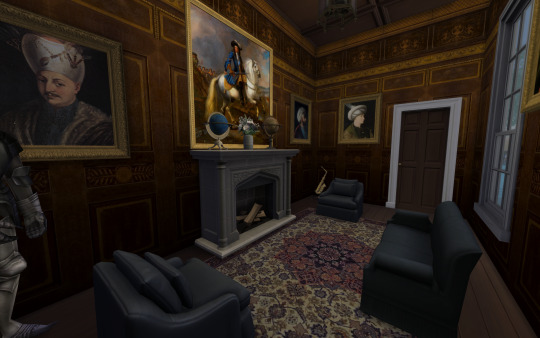

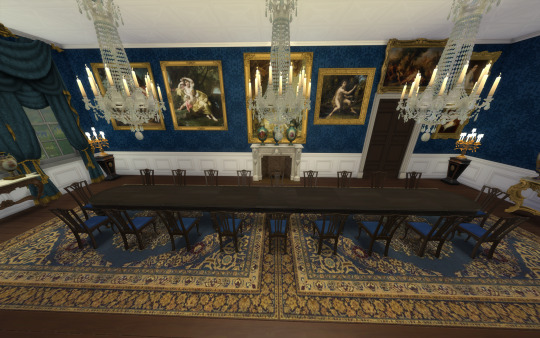



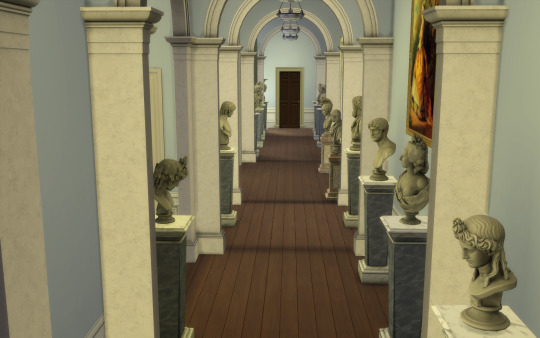
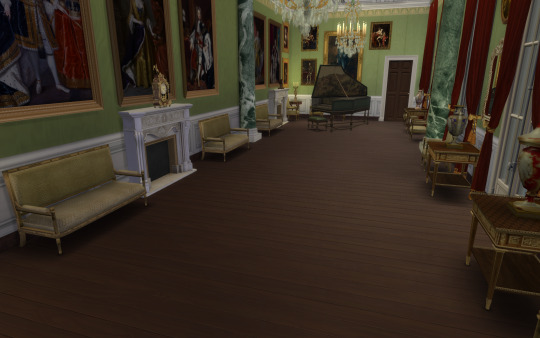



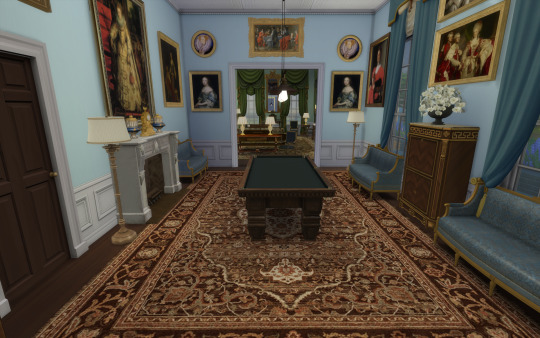

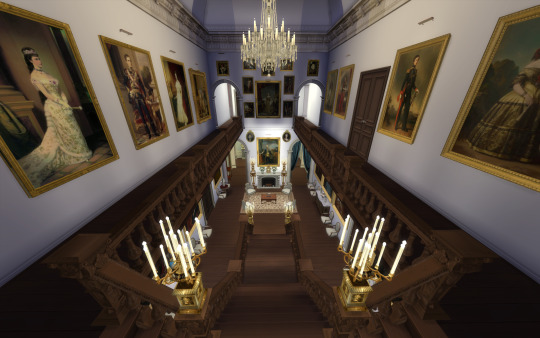


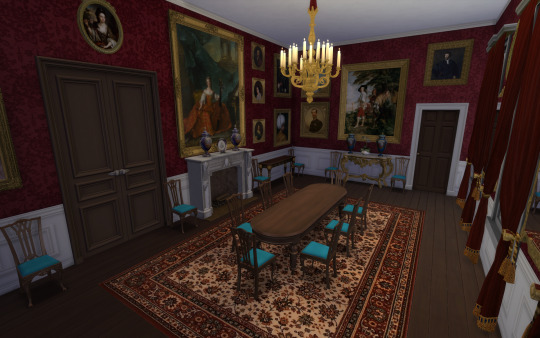





This house fits a 64x64 lot and features the following rooms:
Wooton hall
The painter's gallery
South Drawing room
Billiard room
Long Library
Marlborough room
Sunderland room
State dining room
Principal salon (1st floor) and Spencer's gallery (2nd floor of the salon)
Picture Gallery
Private chapel
The great room
9 Bedrooms/bathrooms
This time I decorated most of the rooms for picture purposes. Hope you like it.
Be warned: I did not have the floor plan for the 2nd floor (Just for the gallery, great room and chapel) The distribution is based on my own decision.
You will need the usual CC I use: all of Felixandre, The Jim, SYB, Anachrosims, Regal Sims, TGS, The Golden Sanctuary, Cliffou, Dndr recolors, etc.
Please enjoy, comment if you like it and share pictures with me if you use my creations!
Early acces: 7/15
#sims 4 architecture#sims 4 build#sims4#sims4play#sims 4 screenshots#sims 4 historical#sims4building#sims4palace#sims 4 royalty#ts4 download#ts4 simblr#ts4#ts4 gameplay#ts4 legacy#ts4cc#the sims 4#sims 4#ts4 screenshots#althorphouse
52 notes
·
View notes
Note
Can you tell me in detail about the friend and inner circle of King Richard iii Or who surrounded the monarch ?
I don't know that by heart but what I do find important on Richard III is:
First, he acquired a close circle of friends from his fosterage at Middleham who would help him to the very end: Sir Robert Percy, Lovell, etc. The most important individual was, of course, Anne Neville.
By enlarging, he had a big northern affinity and networks of allies from his northern years that could count as an inner circle: the Harringtons, Boltons, Bhroughtons, Richard Ratcliffe, etc...
He also had peticuliar friendships with specific individuals that will prove to be decisive just as the one with John Howard, who would be quite important and go back to the late 1460s.
Richard III was quite flexible in his entourage IMO. When we look at how he accepted Catesby and Buckingham in his inner circle quickly, it look like he had an eye for talent and was open for new associations.
However, he was still surrounded mostly by northerners and a king's friendship is deeply political. This will put him into trouble during his reign.
7 notes
·
View notes
Text

🔥 Bonfire Night, a date specific to the United Kingdom, remembers The Gunpowder Plot of 1605 when Catholic conspirators, of which Guido Fawkes was a member of the collective of 13, tried to blow up the Houses of Parliament in order to kill King James I (The Jacobean Era). The goal for this plot was to aid in restoring a Catholic Monarch to the Throne of England.
🔥 After the 16th Century religious Reformations, particularly the 1536 English Reformation under Henry VIII breaking away from the Roman Catholic Church which increased the authority of the Church of England under Protestant ideals. These beliefs were particularly heavily enforced during the reign of Henry VIII's son, Edward VI, though the severity of these later reformations are generally often incorrectly attributed to his father's Henrician Reformation.
🔥 The Tudor reign and Jacobean rule was difficult for Catholics as persecution was rife, though this increased further after the failed plot. Robert Catesby, the man in charge of organising the Gunpowder Plot wanted to replace the Protestant King James I with a Catholic Monarch.
🔥 Despite popular belief, Guy Fawkes was not the leader, he was the Member found first as his job was to set off the fuse for the 36 barrels in the cellar beneath the Houses of Parliament.
🔥 Originally the bonfires were to celebrate the foiled attempt, however, over the centuries it is often commonplace for people to now celebrate the Plotters.
🔥 Read the rest of our article on TheLiverpudlian.com for more information: https://www.TheLiverpudlian.com/post/the-uk-remembers-the-gunpowder-plot-guy-fawkes-on-bonfire-night
👉 Get all of the latest Scouse news, culture and events happening across the Liverpool City Region on TheLiverpudlian.com!
🔔 Turn notifications on so you never miss a post, story or video.
📲 Follow us on Instagram, Facebook, and YouTube to stay up-to-date on all of our posts!
📷 Credit: Original Artwork by Peter Eric Lang.
👋 The Liverpudlian on Social Media:
📰 The Liverpudlian Website.
📱 The Liverpudlian Instagram.
🧵 The Liverpudlian Threads.
🔗 The Liverpudlian Facebook.
🎥 The Liverpudlian YouTube.
📌 The Liverpudlian Pinterest.
🎙️ The Liverpudlian SoundCloud.
🐦 The Liverpudlian Twitter.
📷 The Liverpudlian Flickr.
⚙️️️ Trademark & Copyright 2024, The Liverpudlian, and/or its affiliated brands, unless credit is given otherwise. All Rights Reserved.
#theliverpudlian#the liverpudlian#liverpool city region#liverpudlian#lcr#liverpoolcitycentre#liverpool#liverpoolcityregion#liverpool city centre#scouse#bonfire#guy fawkes
3 notes
·
View notes
Text
My entry: "The Fifth of November." - Aressida. 5.11.23.
I now know more about the failed Gunpowder Plot of 1605, which took place on November 5th, and involved a small group of Catholic conspirators who sought to alter the path of history.
It was one of history's most audacious plots.
It all began in 1604, when King James I declared openly that Catholicism was a superstition.
The conspirators of the Gunpowder Plot, under the leadership of Robert Catesby, were devout Roman Catholics furious with King James I for not allowing Catholics more religious tolerance.
The plotters planned to light a fuse on several gunpowder barrels, 36 of them, that were kept in a rented cellar beneath the Houses of Parliament. This was intended to take place on November 5, 1605, at the start of a new Parliament session including King James I.
The plan came dangerously close to succeeding, but it was only discovered by an anonymous letter to the authorities.
Unfortunately, Fawkes was captured, and the King granted a special order to have him taken to the Tower of London and subjected to torture. Medieval torture device known as "The Rack." Then, in the first month of the year 1606, Fawkes and the remainder of his co-conspirators were pronounced guilty of the capital offense of high treason and were handed down the severe punishment of death, specifically through the methods of hanging, drawing, and quartering.
During the severe political and religious upheaval of the 1500s and 1600s, interrogations frequently involved the use of torture to extract information.
Following the plot's discovery, revelers in London started setting off celebratory bonfires, and in January 1606, a parliamentary act declared November 5 to be a day of gratitude - Thanksgiving. And, Guy Fawkes Day. A reminder to traitors.
All the publicity over the past four centuries has gone to Fawkes, became its figurehead, even though Catesby was the mastermind.
In some circles today, Guy Fawkes is considered as a revolutionary hero because of the 1980s graphic novel "V for Vendetta" and the 2005 film of the same name, which featured a protagonist wearing a mask and fighting against a fascist government in a prospective version of Britain.
The theme of resistance to tyrants and dictators has become more relevant in today's world. The masks are a gesture of unity against political and corporate greed.
Remember, remember the 5th of November.

11 notes
·
View notes
Text
my favourite thing about studying History is that I'll be reading about the real impact of Guy Fawkes on the Gunpowder Plot and suddenly get whacked in the face by some random fact like how Jane Austen was related to Robert Catesby (the real leader of the gunpowder plot)
#english history realistically involves like 5 families#and theyre all inbred#the gunpowder plot was realistically a group of cousins trying to kill another of their distant relatives
9 notes
·
View notes
Text
Let’s Talk About… Fallout! Early History
With the brand-new Fallout television series freshly released, a lot of people have been discussing and diving into the world of the Fallout franchise, particularly the elusive timeline. When is all this happening? Where did our world converge from theirs? What’s with Vault-Tec, the War, and the aliens? Well, today we’ll be diving into a few of these issues.
Welcome to this week’s installment of Let’s Talk About, the internet series where I yap about my hyperfixations for an hour and you all hopefully learn something (even if it’s just for fun)! This time around, we’re starting a journey into the realm of post-apocalypse—before the apocalypse, and before the wars. Welcome to Fallout’s Early History!
Deviations from the real world’s timeline as we know it will be noted minimally. I’m a gamer and a creative, not a historian. All events are mentioned or referenced in-game or during the Fallout series.
(Below the cut to be courteous to y'all's dashboards. Thank you to the Fallout Fandom Wiki editors and fandom researchers for making this post possible! You're all real ones and I'm super excited to be breaking into "the scene" with y'all.)
Our first notch of exploration is sometime prior to 11,000 B.C.E.; we’ll return to this point later in our Fallout episodes, but just remember that it’s important. An alleged extraterrestrial precursor to humanity exists somewhere below the ground.
We begin with two real-world events:
1066 C.E.
March 14th: The Battle of Hastings
The Battle of Hastings was the beginning of the Norman Conquest of England, led by William the Conqueror, or William the Duke of Normandy. The battle was fought slightly northwest of Hastings between the Normen-French army and an English army under the Anglo-Saxon King Harold Godwinson. The Normans won this one, and the proceeding conquest resulted in the royal line as we now know it.
1215 C.E.
The Magna Carta
By 1215, the throne of England had passed hands several times. There had been numerous royal rivalries, rebellions, at least one civil war, and who knows what else—historians know, but I’m not them. At this point, King John of England is on the throne—he’s a direct descendant of that William the Conqueror guy but a lot less cool. After two decades of trying and failing to win one over on France, a bunch of John’s barons had enough of his shit and got together to rebel against him. They were unhappy with the fiscal policies he’d developed to sustain his unsuccessful imperial efforts, and for the way he treated a lot of the nobles. The Magna Carta was drafted as a peace treaty between the King and his barons, severely limiting his power as king.
In Fallout 3, you can find and collect a copy of the Magna Carta from the National Archives through the quest Stealing Independence.
C. 1603
Toshiro Kago’s Abduction,
Sometime during the Tokugawa shogunate, or the Edo shogunate, Mothership Zeta abducted Toshiro Kago.
If you do not want spoilers to Fallout 3 gameplay, please skip to the next section. [Timestamp: ]
Toshiro Kago is a samurai character from the Fallout 3 DLC Mothership Zeta. He’s one of four people the Lone Wanderer thaws out on Zeta and a temporary companion during the This Galaxy Ain’t Big Enough… quest battle. The quest Among the Stars sees the Wanderer return his missing sword to him. He never leaves Zeta but cannot be interacted with after the final battle. He doesn’t speak English and the player character doesn’t speak 16th century Japanese, so conversations with him are stilted, but you get the gist of each other through tone, gestures, and observations.
1605 C.E.
November 4th-5th: Guy Fawkes et al Arrested
The Gunpowder Plot was a failed assassination attempt on England’s King James I and the Parliament. It was organized by Robert Catesby as an effort to end government persecution of Roman Catholics; the hope was to replace the Protestant government with Catholic leadership, however, around midnight on Nov. 4th, Guy Fawkes, one of the conspirators, was discovered in the cellar of the Parliament building with barrels of gunpowder—the plan had been to blow the whole place, king included. Fawkes and others were arrested, tried, and executed for treason by the 5th. Now, every November 5th, England sees Guy Fawkes Day, where effigies of Fawkes are burnt.
1612 C.E.
Point Lookout Deviation
In reality, Captain John Smith landed ashore at Point Lookout in 1608, just a year after establishing the Jamestown colony in Virginia. However, in Fallout, Smith doesn’t come ashore there until 1612—it seems that this deviation kicked off further deviations, such as the Ark and Dove Deviation.
As a location, Point Lookout is only available in the Fallout 3 DLC of the same name. The Lone Wanderer can spend an awful lot of time here.
1634 C.E.
Boston Common Established
The Boston Common is considered the oldest public park in the U.S.; it’s played an important role in the history of landscape architecture, the military, politics, conservation, and recreation in Massachusetts. In 1634, the people of Boston (MA Bay Colony) voted to tax each house six shillings to purchase William Blackstone’s farm as a community common—thus the Common was born! It’s still an important cultural piece of land—so much so that it’s a main location in Fallout 4.
In the Fallout universe, Boston Common is home to the Swan, Tour bots, and Vault 114. All Boston locations, to my knowledge, are only available in Fallout 4.
March 25th: Arc and Dove Deviation
In reality, when Lord Baltimore dispatched the colonists aboard the Ark and Dove ships, they landed at Saint Clement’s Island, Maryland; in Fallout, they landed ashore Point Lookout. There, they constructed the Ark & Dove Cathedral. The Ark & Dove resting grounds are another location influenced by this event, It can be assumed that the Point Lookout Deviation led to this major difference.
The Cathedral and the resting grounds are a part of the Point Lookout DLC in Fallout 3, and are home to smugglers, swampfolk, feral ghouls, and three quests: Hearing Voices, Walking with Spirits, and Tailing the Tomboy.
1660 C.E.
Old Granary Burying Ground
The burial ground was established on Tremont Street within the Boston Commons. Its current name is from the adjacent granary that was built in the 1730s. That establishment was torn down and replaced by the Park Street Church in 1809—the name for the burying grounds persisted, of course. In Fallout, it is Boston’s oldest surviving burial ground. There are a variety of references to other historical moments within and around the burying ground. It’s now inhabited by feral ghouls.
1680 C.E.
The Paul Revere House Built
While unmarked in-game, the Paul Revere House is the oldest standing building in Boston, even post-bombings. Outside the building, there’s now a Freedom Trail marker, a pre-War plague about Revere, and the plague reads: “Built in 1680, this wooden building is the oldest structure in all of Boston. In 1770 this home was bought by famed patriot Paul Revere. … Revere dwelled here with his family (including his 16 children) until 1800. Paul Revere was living here when he made his famous midnight ride to Lexington and Concord to warn Samuel Adams and John Hancock that Redcoats were en route to arrest them and seize the militia weaponry.” It’s generally considered a myth that Revere made that journey.
1690 C.E.
Publick Occurrences Published
Publick Occurrences Both Forreign and Domestick was the first multi-page newspaper published in British colonial America. Its first issue carried an account that “offended” the colonial governor, and the paper was promptly closed by colonial authorities days later. No other paper was published in the colonies for over a decade.
1692 C.E.
The Salem Witch Trials Begin
The trials of Salem, MA, are pretty infamous. During the trials, numerous Salem Village residents accused others (mostly Protestants, the impoverished, slaves, and disliked folk) of “witchcraft.” However, there is no evidence that those accused practiced or recognized any form of witchcraft. The accused were arrested, tried, and often hanged. These events made the larger neighboring establishment, Salem Town, a tourist location for the ages—Salem Town was the more affluent of them.
After the Great War, the town’s residents worked to make it a secure settlement, with much success until an onslaught of Mirelurks sometime before the Sole Survivor arrives in Fallout 4. It’s home to two quests: The Devil’s Due and Gun Run. In the Mothership Zeta add-on for Fallout 3, Fallout Shelter and Fallout 76, the location is also mentioned.
1697 C.E.
May 17th: Andrew Endicott Abducted
Another victim of the Zeta in the Fallout 3 add-on, Endicott was abducted from his Salem Village home on May 17th. A recorded log enlightens the Lone Survivor to some of his story, which the aliens asked him to record. He is fearful of aliens, and rightly so.
1711 C.E.
The Great Fire in Boston
Note: “The Great Fire” is a term that has since been applied to the fire conflagration of 1760, which compared to the 1711 fire was much more devastating. However, in 1711, the conflagration destroyed the establishment’s first townhouse.
The Cabot House Built
Beacon Hill becomes the home of the Cabot House and its owning family. The Cabots are an affluent family who were well-known and connected in pre-War high society. Post-War, they’ve maintained their wealth and a network of hired help, overseen by their family “servant” Edward Deegan. The most prominent member of the Cabot family was Lorenzo Cabot, an archaeologist ridiculed for his theories of an extraterrestrial precursor civilization on Earth.
1713 C.E.
The Old State House Built
Eventually becoming the oldest public-access building in Boston, the Old State House was where “the child independence was born.” (John Adams) Miraculously, it survived the Great War in its entirety and has since become the headquarters of the Neighborhood Watch and John Hancock.
1714 C.E.
The Soil Stradivarius Manufactured
One of the most prized instruments ever made by Italian craftsmen Antonio Stradivari, the two-century-old Soil (pronounced “swal”) was owned pre-War by Hilda Egglebrecht. It can be found in Fallout 3’s Vault 92, in the case and as part of Agatha’s quest Agatha’s Song.
1723 C.E.
Old North Church Built
Eventually gaining the title of “oldest church in the city,” Boston’s Old North Church was built in 1723. It is still the tallest standing church, with its steeple reaching nearly 200 feet. It is now home to the Railroad and connected to their HQ. There are catacombs from the Revolutionary War underneath it. It’s only found in Fallout 4.
1733 C.E.
Trinity Church is a parish of the Episcopal Diocese of Massachusetts, and the original site (on Summer Street) was burned down in the Great Fire of Boston of 1872. The current church was erected under Rector Philips Brooks in the 1870s. The Sole Survivor can explore it, so long as they are ready to confront several mutants. It’s a location in several quests, including, Cleansing the Commonwealth, Diamond City’s Most Wanted, Leading by Example, and Randolph Safehouse.
1742 C.E.
Faneuil Hall Completed, Donated
Nicknamed “the Cradle of Liberty,” Faneuil Hall was donated to the city of Boston in 1742 by Peter Faneuil and it later served as a commercial hub in colonial Massachusetts. Shem Drowne’s gilded grasshopper, constructed that year, sits at the top. The Sole Survivor can explore it in Fallout 4.
May 25th: Gilded Grasshopper Created
In Fallout 4, the Grasshopper is a unique junk item and part of the quest The Gilded Grasshopper, after which, it has no other uses. It was created in 1742 by Shem Drowne and placed atop Faneuil Hall. In Fallout 4, it is found as a windvane on the roof of the building, and a replica can be found in Fallout 76, in Appalachian Antiques. It cannot be picked up.
1755 C.E.
The Cape Ann Earthquake
The Cape Ann quake damaged much of Massachusetts, including the colony of Boston. It remains the largest earthquake in the history of Massachusetts. No one was killed, but the east coast saw a load of physical damages, including Boston and its Faneuil Hall. The Gilded Grasshopper was damaged.
1768 C.E.
June 28th: Gilded Grasshopper Restored
Shem Drowne’s son Thomas restores and returns the Gilded Grasshopper to the top of Faneuil Hall in Boston, Massachusetts. He placed a note inside the Grasshopper, which according to Marty Bullfinch leads to Shem’s treasure. The note is a minorly altered version of a real letter placed inside the hopper in Boston. The only difference between them is the line about Drowne’s treasure. In Fallout 4, the note leads to Shem’s burial and a variety of items buried with him.
We’re now on the brink of the Revolutionary War, which we’ll pick back up at in our next episode of Fallout discussion. For now, I hope you’ve enjoyed, I hope your urge to explore the worlds of Fallout has been tickled, and I hope you’ll like, comment, and subscribe/follow me here and on my socials. I hope you have a wonderful time. Bye-bye!
#anxious autist (me)#creative writing#fallout#fallout series#fallout games#fallout timeline#fallout lore#fandom#my writing#Let's Talk About... (Typed Series)
2 notes
·
View notes
Text
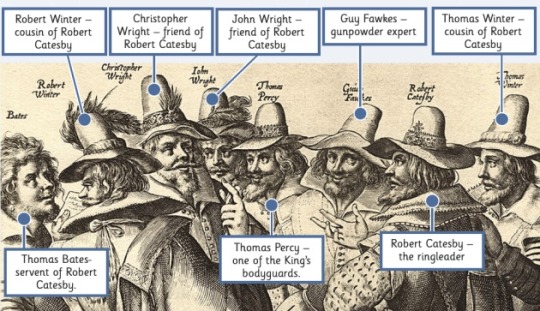
In 1603, two Catholic plots against the new King James I had been foiled. James retaliated by strengthening existing anti-Catholic legislation. In 1604, unwilling to endure any more time under a Protestant monarch, wealthy Catholic Robert Catesby gathered together a gang of his friends, relatives and servants and began working out a plot to kill James. Other members of the group later joined, including explosives expert Guy Fawkes. Some of the key members of the plot can be seen above.
4 notes
·
View notes
Photo









icons of Kit Harington in Gunpowder (2017) as Robert Catesby
#kit harington icons#gotcastedit#period fc#kharingtonedit#kitharingtonedit#gunpowderedit#robert catesby#kit harington#gunpowder#rp icons#icons#rpg resource#*icons#*mine
39 notes
·
View notes
Text
Seeing Treason yesterday was great if just for Connor Jones’ performance as Robert Catesby alone. Genuinely I think it’s one of my favourite performances I’ve ever seen, as it really changed my perception of the character. I always viewed Catesby as a rather stoic, mysterious character who in a sense is numb because of the death of of his wife, at least that’s what I felt from both Hadley’s recording and Simon-Anthony’s performance in the concert. But Connor genuinely brought a whole new level to the character. He portrayed a man on the edge, so broken that he would do anything to get revenge and take down those who he believed did this to him. He’s not numb to the pain but actively craving death and is extremely neurotic, even unfeeling towards those who are meant to be on his side. He’s smart and manipulative, yet you can see his pain so clearly that you can’t help but want him to succeed in some regards. While of course there is so much beauty in Hadley’s performance on the recording of ‘The Cold Hard Ground’, Connor brought a real raw energy which I absolutely loved. I felt his pain in every note and he really sold Catesby’s dissociation as his plan failed. Genuinely I feel like it was the best portrayal of everyday suffering I’ve seen on the stage, the suffering that someone has to live with everyday while maintaining a fake persona. It was such a great performance and I really wish I could see it again.
#Treason the musical#Connor Jones#I know none of my followers care about this but damn it was just so good
2 notes
·
View notes
Text
Remember, remember, the fifth of November...
In the early hours, on this day (05 Nov) in 1605, a storeroom below the House of Lords was searched for the second time, following suspicions raised following inspections the previous day; the search party found the room guarded by a man, armed with matches and fuse, who gave his name as 'John Johnson'. Underneath piles of wood and coal, 36 barrels of gunpowder were discovered.

Officials had uncovered the plot which had been masterminded by Catholic Robert Catesby, increasingly frustrated and disillusioned with the restrictions being placed on Catholics by the new monarch, James I. His plan was strike at the heart of government: to blow up Parliament House during the State Opening of Parliament, at which time the King, Queen, perhaps his heirs, and all counsellors would be present. Catesby had drawn other Catholic men to his cause, including Thomas Wintour, Jack and Kit Wright, and Thomas Percy: 13 co-conspirators in total.
Whilst 'John Johnson' admitted to the intent to blow up parliament, he refused to give his real name (until 48 hours of interrogation and torture later when he confirmed it as 'Guido Fawkes'), as well as the name of his co-conspirators. One man's involvement however was confirmed, the man who had rented the vault: Thomas Percy, one of the King's Gentleman Pensioners (Royal Bodyguards).
A proclamation was issued the same day for the 'search and apprehension' of Thomas Percy, for his role in "one of the most horrible Treasons that ever was contrived". However, Percy had left London on the news of the foiled plot, heading north towards the Midlands along with other co-conspirators, in an attempt to gather Catholic support.

On order of the Lord Mayor of London, bonfires were lit on the evening of the 05 Nov, in celebration of the discovery of the plot and survival of the King, as well as with the intent to provide light and reassurance to many confused and frightened Londoners.
#gunpowder plot#powder treason#history#london#London history#Thomas percy#Robert catesby#guido fawkes#guy fawkes#James i
0 notes